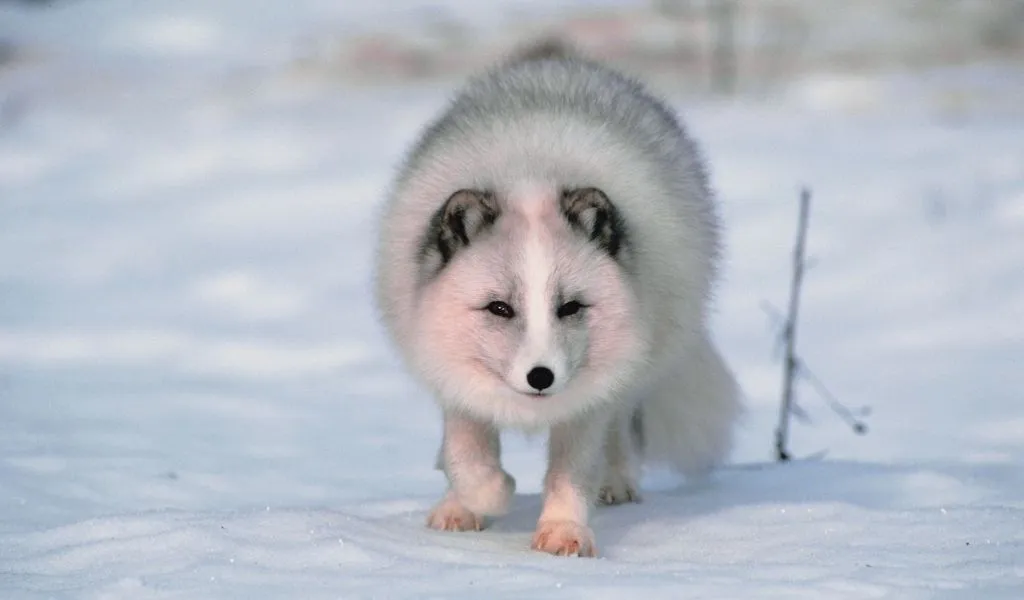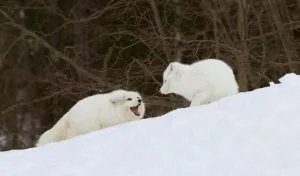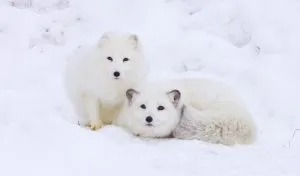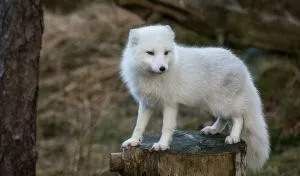Living in the extreme climates of the arctic tundra can bring many challenges for arctic foxes (vulpes lagopus), not least the varying seasons that bring changes in food supply and their surroundings. During the winter months, do arctic foxes hibernate or migrate?
Neither, 95.5% of arctic Foxes do not hibernate nor migrate. Instead, they adapt to the changing climate by growing a winter fur coat for better camouflage. When food is scarce, they might take short commuter trips to nearby sea ice to find food sources.
A small minority of arctic foxes do migrate, often from inland to coastal areas or even across continents. Keep reading to find out more about the hibernation and migration habits of arctic foxes and how they adapt to survive in winter.
Do Arctic Foxes Hibernate in Winter?
Hibernation is how animals conserve energy to get through a lack of food in winter. It involves a reducing metabolic rate which leads to decreased heart rate and lower body temperature for extended periods1 (source: Australian Academy of Science).
Arctic foxes do not need to hibernate in Winter as they can adapt to the changing climates and are still able to catch food.
These animals have adapted to survive in cold environments, their excellent hearing allows them to hear small rodents such as lemmings as they scuffle through the snow. They will listen carefully to the high-pitched noise that the rodents make to locate them and at the opportune moment, they will dive into the snow headfirst and usually emerge with a lemming in their mouth.
Arctic foxes are opportunistic omnivores so they will eat anything they can find. They are known to take short commuter trips to nearby sea ice to feed on carcasses left behind by polar bears.
Occasionally, arctic foxes might take a mini-hibernation when food is scarce. They will dig a den and remain there to hide from predators. This allows them to reduce their heart rate and metabolic rate in a similar way to hibernation, although this typically lasts for just two weeks rather than the entire winter2 (source: National Geographic).
Do Arctic Foxes Migrate?
No, the majority of arctic foxes do not migrate for winter. In regions of the tundra where there is sea ice such as Russia, Alaska, and Canada, they are residential, opting to take short-term ‘commuting’ trips to nearby sea ice in search of food which usually lasts 1-3 days before returning3 (source: OIKOS, S. Lai. et al, Vol 126, Issue 7, July 2017).
However, there are some arctic foxes that migrate, although this is less than 5% of the total population.
For example, in Iceland where there is no sea ice, arctic foxes that usually live inland and feed off rodents during the summer will migrate to coastal areas for the winter where seabirds and fish will be more abundant than rodents.
Those that do migrate will often use moving sea ice as a means of transportation between continents. One example of this was recorded in detail in 2017 when one blue arctic fox was tracked migrating more than 3,500km from Norway to Canada in just 76 days4 (source: The Guardian).
Fun fact: Arctic foxes originally colonized Iceland around 200-500 years ago during a ‘mini ice age’ when sea ice allowed them to travel from Russia, Alaska, and Canada to Iceland. When temperatures warmed, the sea ice melted and isolated the foxes in Iceland5 (source: Durham University).
How Does an Arctic Fox Survive the Cold?
Arctic foxes have become well adapted to living in colder climates with a short muzzle, ears and legs, and a short, rounded body.
Arctic foxes change the color of their fur coat to blend in with their surroundings, adopting a white color for the snowy winters and a brown/grey color to blend in with the rocks in summer when the ice has melted.
Arctic foxes are known to be able to survive in temperatures as low as -50°C (-58°F)6 (source: National Geographic).
They have thick fur that traps air and keeps them warm. They use snow lairs or dens below the snow to shelter from the elements. They will often curl up in a rounded position which ensures only the most well-insulated parts of their body are exposed to the cold.
During winter, food can be harder to find, especially for inland arctic foxes who have a less stable food source. To help with this, they will store excess food in the Earth or under stones in their den ahead of winter. Researchers have observed them storing more than 100 sea birds.7 (source: Adaptations by the Arctic Fox (Alopex lagopus) to the Polar Winter, P. Prestud, Arctic, Vol 44, No. 2, June 1991).
Can Arctic Foxes Live in Warm Climates?
No, arctic foxes are only found in the arctic tundra and cannot live in warmer climates. They have adapted to the changing temperatures of the tundra which range from an average -34° C (-30° F) in winter up to 3-12° C (37-54° F) in summer8 (source: University of California Museum of Paleontology).
Further south, the rival red fox is better suited to warmer climates and woodland. They are superior hunters and their year-round red/brown coat provides better camouflage where there is less snowfall.
As the climate warms due to global warming, more native plants are able to flourish in the tundra which results in parts of it turning to woodland. This has allowed the superior red fox to encroach further north and has resulted in arctic foxes becoming endangered in some regions of Fennoscandia.
When Does the Arctic Fox Sleep?
Although arctic foxes are mostly nocturnal, they are more adapted to hunting in daylight than their counterparts such as the kit fox and the red fox9 (source: The American Naturalist, J.L. Kavanau, and J. Ramos, Vol 109, No. 968, 1975), so they are very flexible. This is because they live in the arctic where it can be dark for more than 24 hours in winter and light for more than 24 hours in summer.
Their brilliant eyesight, excellent hearing, and camouflage allows gives them a strong advantage to catch prey during the day without being spotted by their predators.





